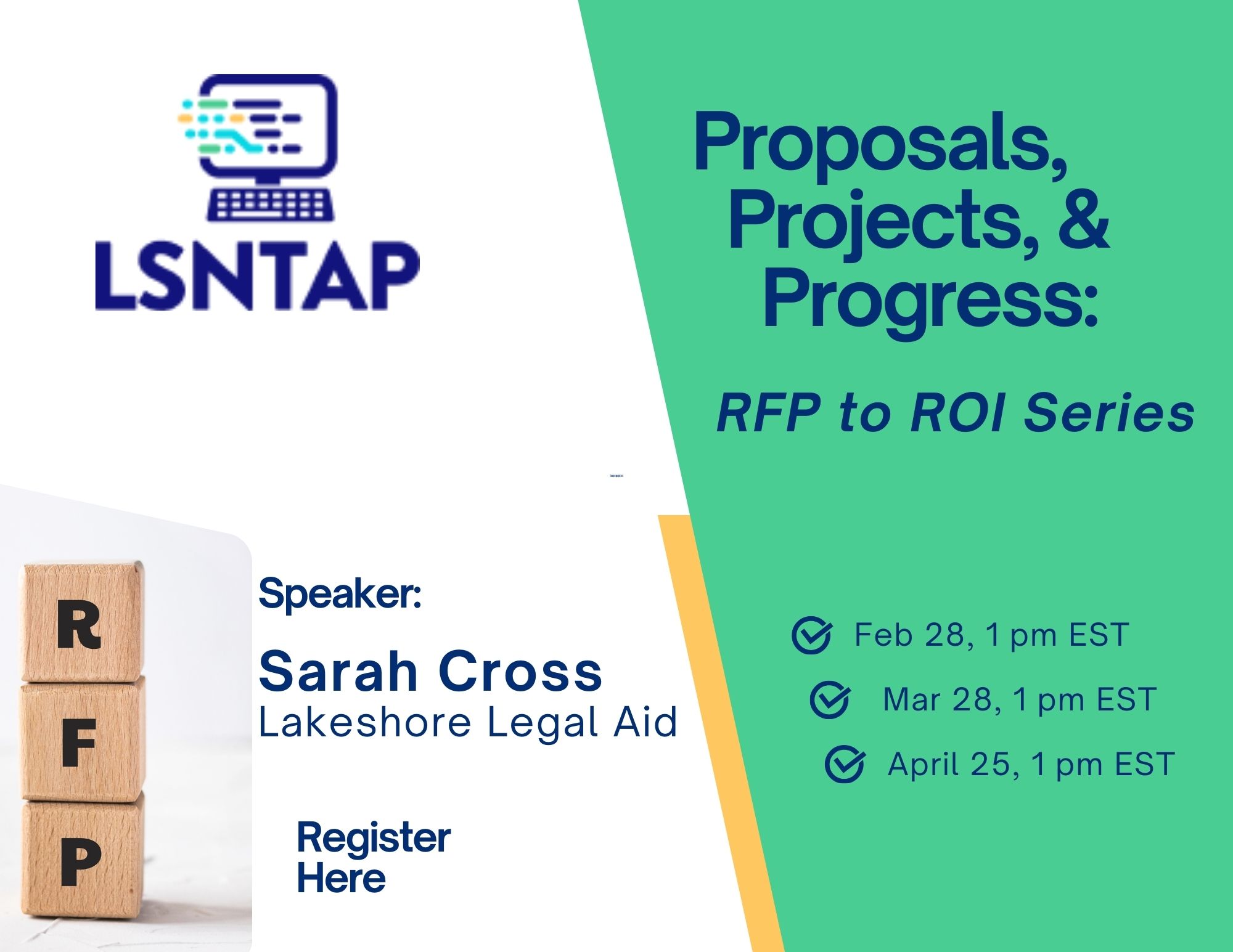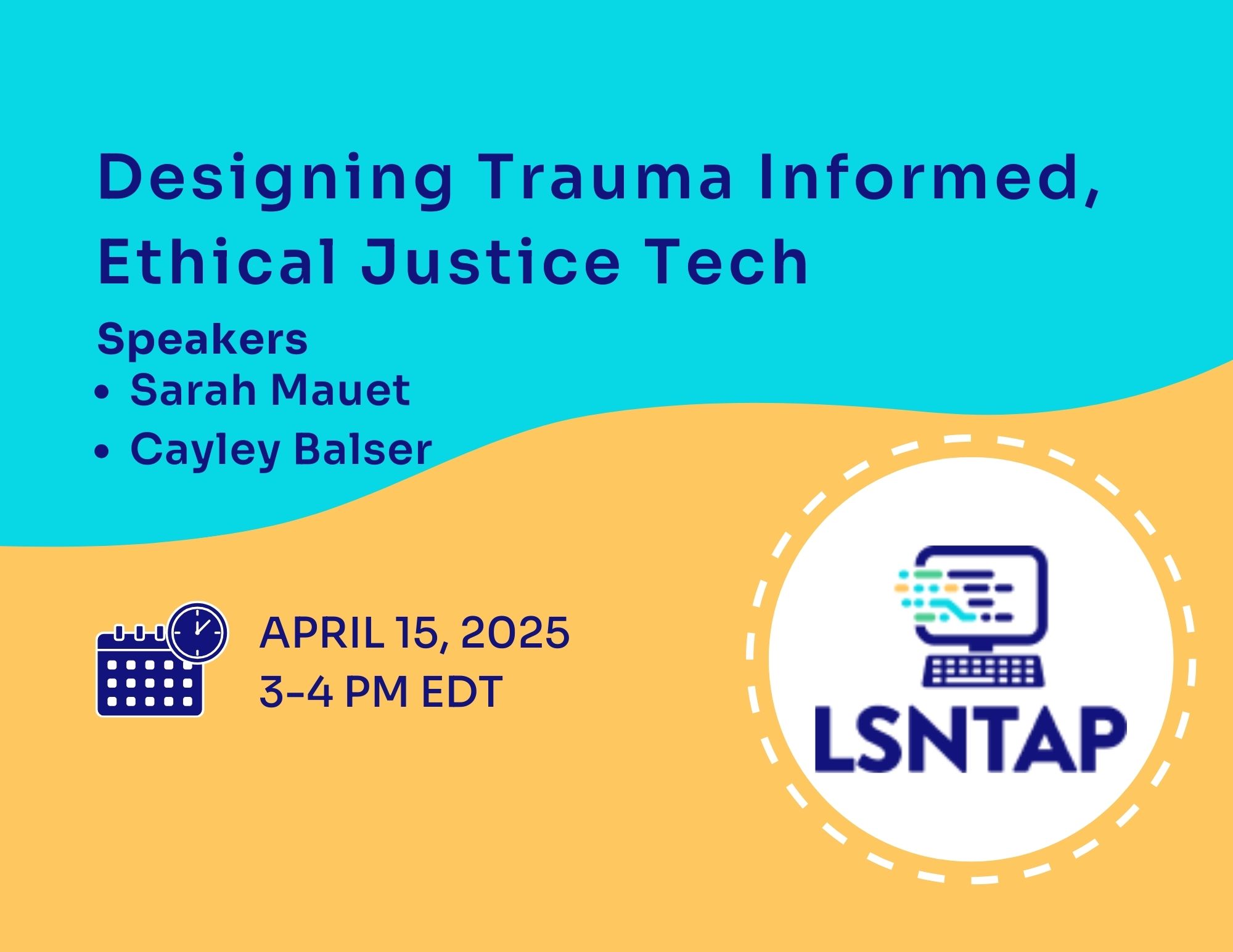Presented by
Laura Quinn of Idealware
John Greiner of Just Tech, LLC
Brian Rowe of LSNTAP
What’s the benefit of a tech investment, and when it is worth the expense? What’s the best way to think about the return on investment of a technology project in quantitative terms? In this session, we’ll talk through the core concepts around how to consider and weigh the costs and benefits of technology projects. Then we’ll work together as a group to collaboratively identify some of the most effective and measurable elements you can use to predict the return on investment for innovative projects. You’ll leave with a clear framework to help you think through innovative technology investments at your own organization.

There are likely line items in your budget that you wish you could cut down or eliminate completely. For example, attorneys in large states often have to travel great distances to see clients and occasionally have to stay overnight. Implementing technology that allows clients to speak with an attorney remotely could save hundreds of dollars per client.
Many service delivery technologies promise huge time savings. For example, a document assembly system could significantly reduce the amount of time an attorney spends helping clients fill out routine paperwork. To determine how big your time savings will be, estimate how much time each paperwork task takes you and how often your organization completes that task. Then think through how much time it would take with a document assembly system. The difference is your time savings.
Central to every legal aid organization’s mission is the belief that every litigant deserves fair representation. Unfortunately, limited time and funding are barriers to that goal. Client numbers are relatively easy to track—any case management system will help you do this—but you’ll need to also think about self-help clients and how to count them. For example, you might use web analytics or a system that requires online users to create a profile to capture this information. Kiosks, mobile apps, and other mobile outreach efforts should also include ways to count the number of people reached.
Sometimes organizations struggle just to provide minimal services and can never fully provide what they know their clients really want or need. For example, combined triage and intake systems can help applicants get more information and go more quickly to where they can get the most help. For people who would otherwise be turned away because they don’t qualify for legal aid, document assembly and expert systems provide them with more in-depth help than they would get doing a Google search or trying to fill out the forms alone at their kitchen table.

Figuring out how to measure the value of additional clients served or an improvement in the quality of services can be tricky. One way might be to consider how much the client him or herself would pay to get the services or increase the quality of those services. Another way is to calculate how much taxpayers might save if more people receive your services or get a higher level of service from your organization.
Next, start thinking about your goals and how to link them to things you can measure. Are you seeking to serve more clients? Or shorten the amount of time attorneys spend on routine tasks? To track your progress against each of these goals, you will need metrics that quantify them. This might not always be direct: For example, you can estimate the amount of time an attorney currently spends with each client by tracking it for a week and calculating an average. Or you could use client satisfaction reports as a proxy for the successful outcome of the case. Don’t feel you need to have one definitive number in any particular category. The idea isn’t to have perfect measures—just ones that are useful.
Once you have tracking metrics in place, you need to assign plausible values. For example, if saving attorney time is valuable to your organization, then you need to define how much time you could plausibly save. For instance, maybe you could save at least two minutes per client on average, but there’s no way you’re going to save more than ten minutes per client. If you then multiply each end of the range by a plausible hourly rate for an attorney, and multiply the number of clients the attorney might see, you have a high and a low value for the plausible cost savings.
It’s important to stress: This is not science. The values are estimates and are being derived as units of comparison. In the example we just looked at, the organization did not save $2,133 real dollars. What we can learn is that another project that costs twice as much, but could save four times more attorney hours, plausibly offers a better return on investment.
Hardware and software are the most obvious costs of any technology project. You may be able to get a good estimate of these costs online. If not, call a few vendors—most will give you a ballpark price.
It’s important to remember that much of this cost is absorbed in the first year. To get a good sense of the true cost of your project, a five-year view makes the most sense. This multi-year perspective allows you to account for lower equipment or licensing costs in the years after implementation.
Also, keep in mind that your project has two halves. When estimating, make sure you account not only for the cash going to software or hardware, but also the staff time and consultant dollars that go into planning, designing, and completing your project.
New systems often mean carrying out familiar processes in a new way. You’ll need rules in place to make sure people are using the technology properly and you’ll need to assign someone to be responsible for maintenance. But most importantly, you’ll need to spend time training people on your new system. It doesn’t matter how big a step forward your project is for the organization if no one knows how to use the technology.
If you choose to hire a consultant, you’ll need to define an approximate cost. It’s probably easiest to think of it as a range of hours and then an hourly wage. Most consultants will be happy to talk to you and give you a ballpark estimate of how much you might need to budget, likely with the hope of being on your list when you’re looking to hire. You can also talk to other organizations that have hired consultants for similar projects to get a sense of how long it took and how much they charged.
Even if you hire someone to do most of the work, there will still be staff time required—to talk about goals, define requirements, make decisions, define processes, get trained, and more. List out the steps for your project and take a crack at estimating the people who will be involved and the number of hours for each.
If you feel you have no idea how much time it might take, consider asking a consultant to help you come up with a rough estimate.
And don’t forget to factor in the ongoing costs of maintaining your project in year two and beyond. It’s unlikely that you’ll be able to simply launch your technology into the world and then stop investing any time or money. Services such as document assembly or online learning tools will need to be updated with new content as laws change, so make sure you budget enough and have a plan for keeping it running long term.
Also, make sure to calculate in the cost of diverting time and attention from other work. Your attorneys may need to spend less time with clients during your technology project. Will the resulting technology help you make up that lost time? Is the long-term benefit big enough to justify any short-term losses?
The slides for the presentation can be found here.
http://www.slideshare.net/LSNTAP/determining-the-roi-on-innovative-tech
And please fill out this survey to help us continue to bring you these videos.
https://www.surveymonkey.com/r/68H6D5X




